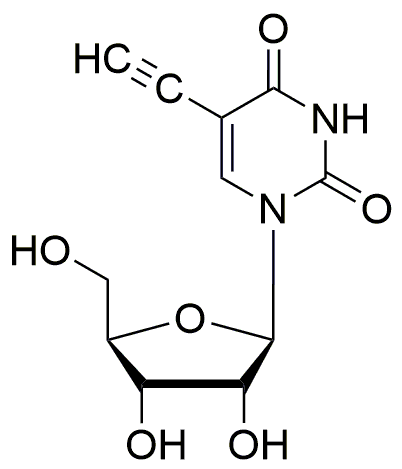5-Ethynyl Uridine (5-EU) is widely utilized in research focused on:
- Antiviral Research: 5-EU is a key compound in the development of antiviral therapies, particularly against RNA viruses. Its ability to inhibit viral replication makes it a valuable tool in drug discovery.
- RNA Studies: This compound is used in RNA labeling and tracking experiments, helping researchers understand RNA dynamics and functions in cellular processes.
- Drug Development: 5-EU serves as a building block in the synthesis of nucleoside analogs, which are crucial in creating new medications for various diseases.
- Biotechnology: In the biotech industry, 5-EU is employed in the development of RNA-based therapeutics, offering potential treatments for genetic disorders.
- Research on Cellular Metabolism: The compound aids in studying metabolic pathways involving nucleotides, providing insights into cellular energy processes and their implications in health and disease.
General Information
Properties
Safety and Regulations
Applications
5-Ethynyl Uridine (5-EU) is widely utilized in research focused on:
- Antiviral Research: 5-EU is a key compound in the development of antiviral therapies, particularly against RNA viruses. Its ability to inhibit viral replication makes it a valuable tool in drug discovery.
- RNA Studies: This compound is used in RNA labeling and tracking experiments, helping researchers understand RNA dynamics and functions in cellular processes.
- Drug Development: 5-EU serves as a building block in the synthesis of nucleoside analogs, which are crucial in creating new medications for various diseases.
- Biotechnology: In the biotech industry, 5-EU is employed in the development of RNA-based therapeutics, offering potential treatments for genetic disorders.
- Research on Cellular Metabolism: The compound aids in studying metabolic pathways involving nucleotides, providing insights into cellular energy processes and their implications in health and disease.
Documents
Safety Data Sheets (SDS)
The SDS provides comprehensive safety information on handling, storage, and disposal of the product.
Product Specification (PS)
The PS provides a comprehensive breakdown of the product’s properties, including chemical composition, physical state, purity, and storage requirements. It also details acceptable quality ranges and the product's intended applications.
Certificates of Analysis (COA)
Search for Certificates of Analysis (COA) by entering the products Lot Number. Lot and Batch Numbers can be found on a product’s label following the words ‘Lot’ or ‘Batch’.
*Catalog Number
*Lot Number
Certificates Of Origin (COO)
This COO confirms the country where the product was manufactured, and also details the materials and components used in it and whether it is derived from natural, synthetic, or other specific sources. This certificate may be required for customs, trade, and regulatory compliance.
*Catalog Number
*Lot Number
Safety Data Sheets (SDS)
The SDS provides comprehensive safety information on handling, storage, and disposal of the product.
DownloadProduct Specification (PS)
The PS provides a comprehensive breakdown of the product’s properties, including chemical composition, physical state, purity, and storage requirements. It also details acceptable quality ranges and the product's intended applications.
DownloadCertificates of Analysis (COA)
Search for Certificates of Analysis (COA) by entering the products Lot Number. Lot and Batch Numbers can be found on a product’s label following the words ‘Lot’ or ‘Batch’.
*Catalog Number
*Lot Number
Certificates Of Origin (COO)
This COO confirms the country where the product was manufactured, and also details the materials and components used in it and whether it is derived from natural, synthetic, or other specific sources. This certificate may be required for customs, trade, and regulatory compliance.


